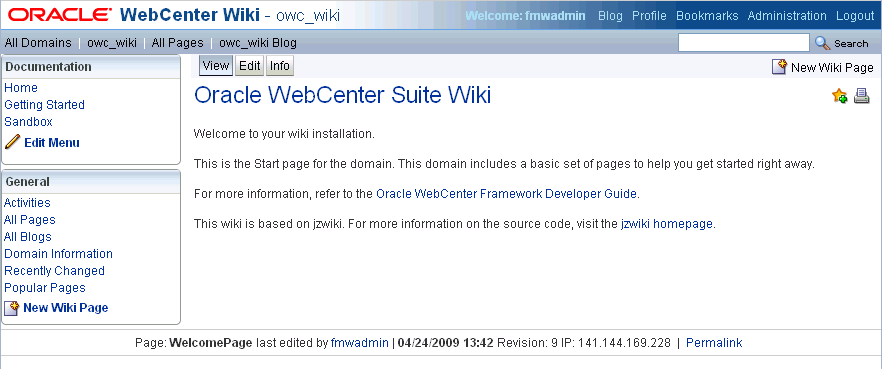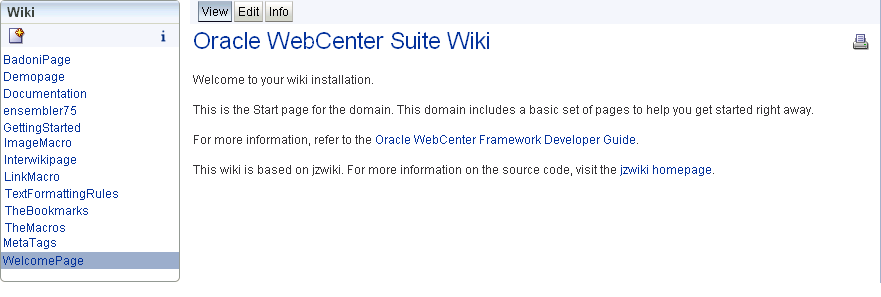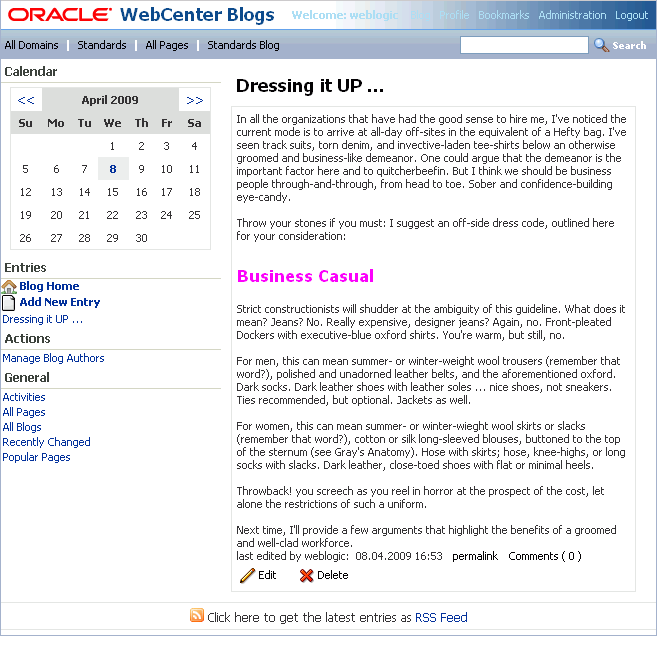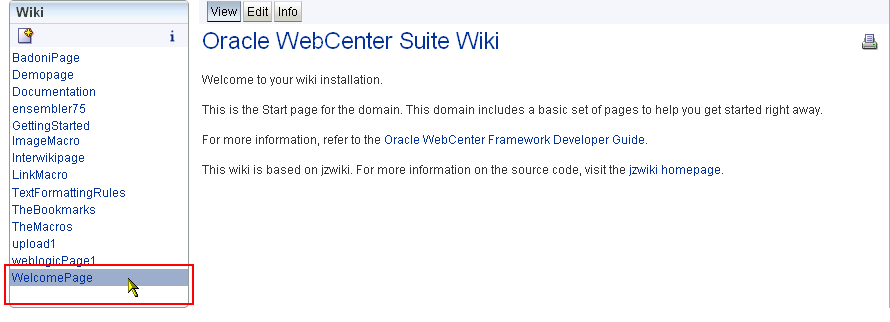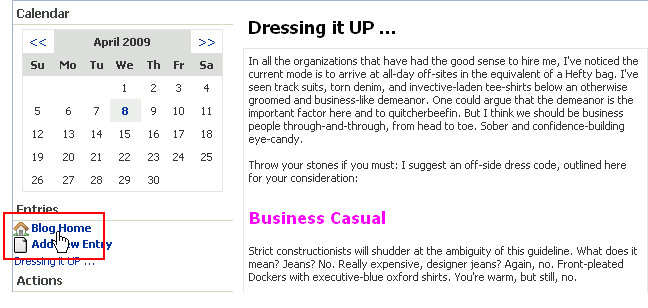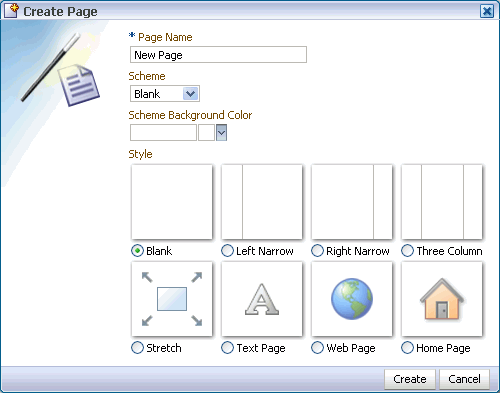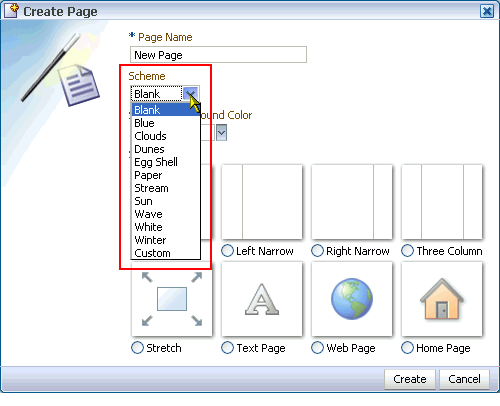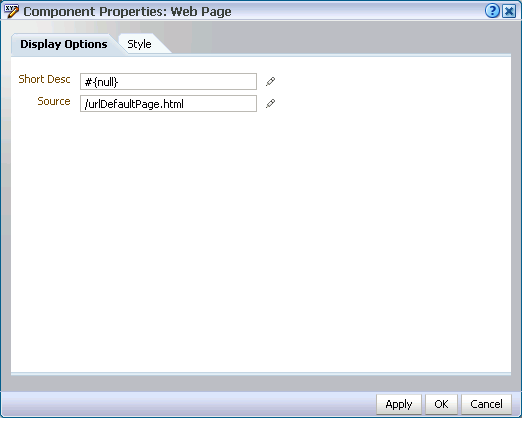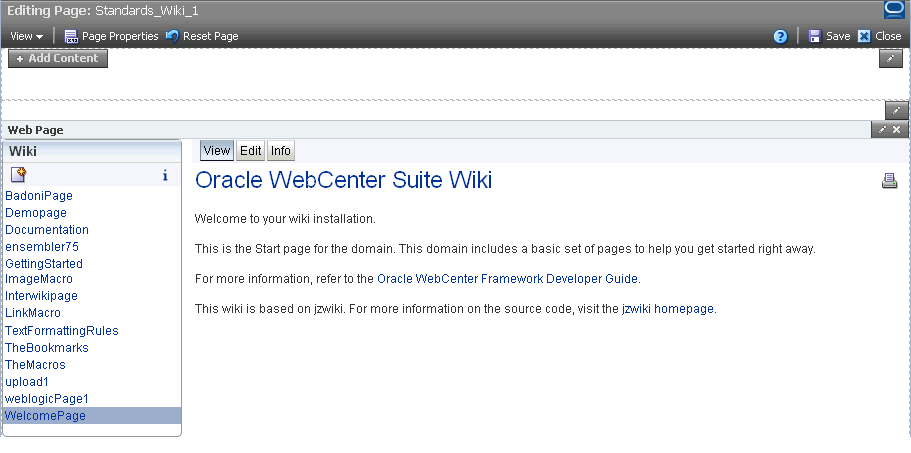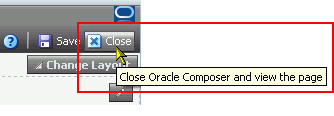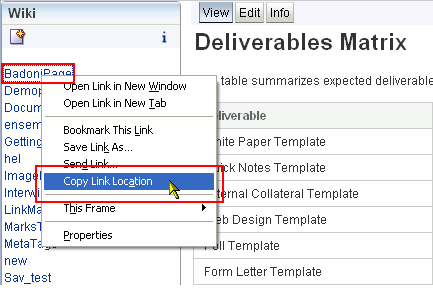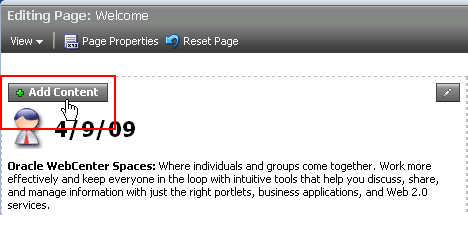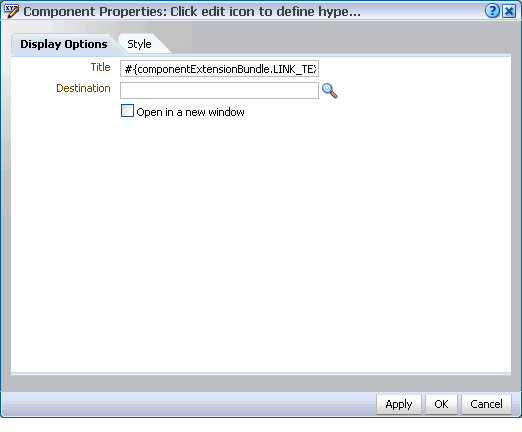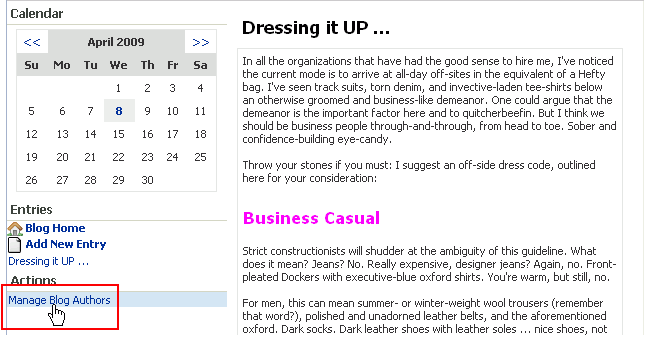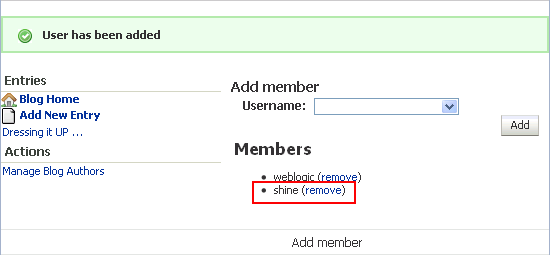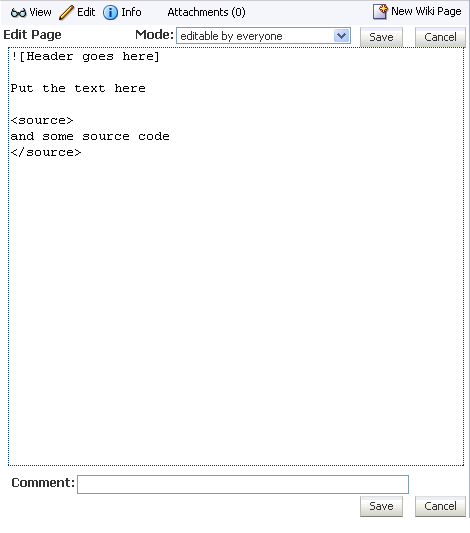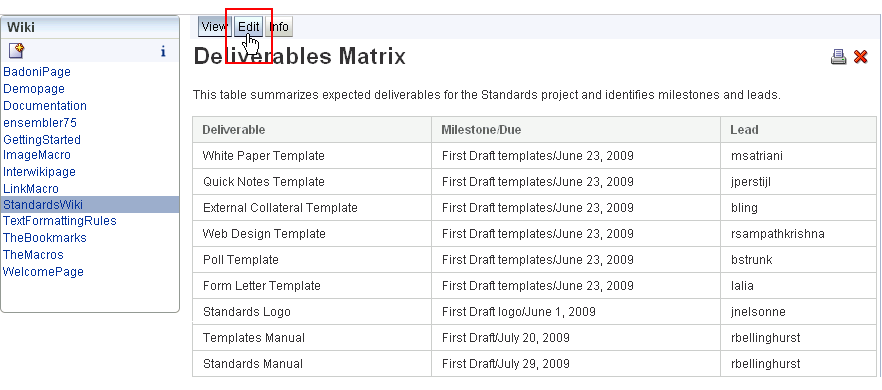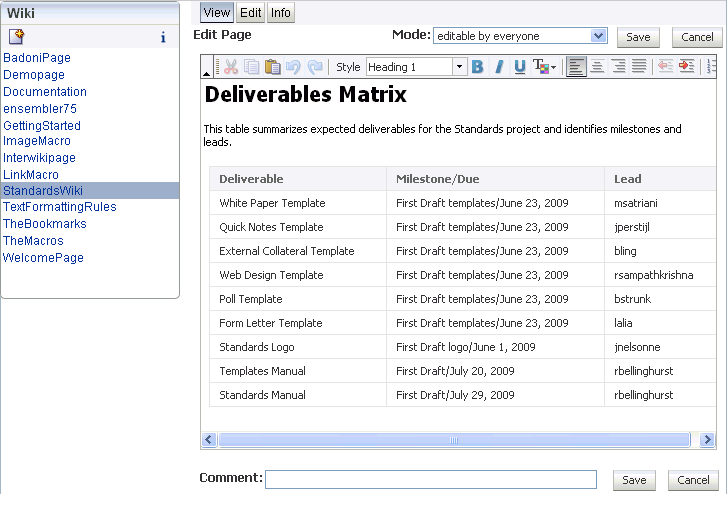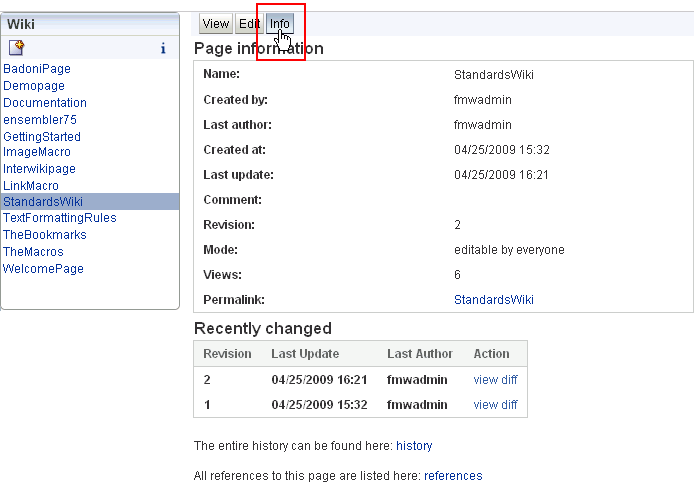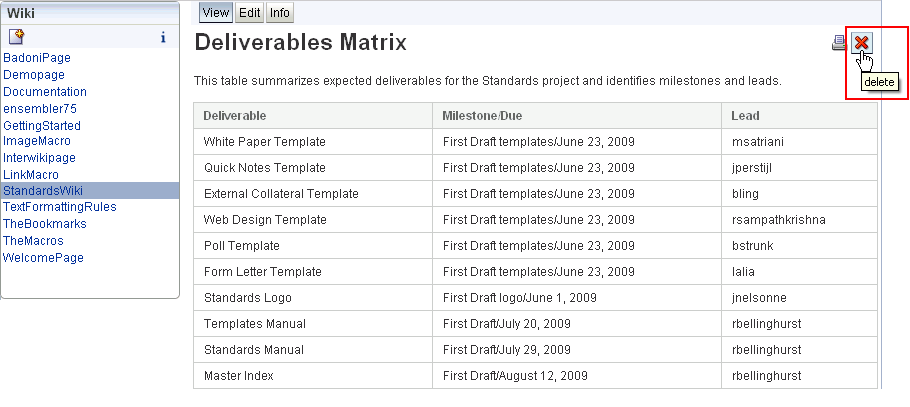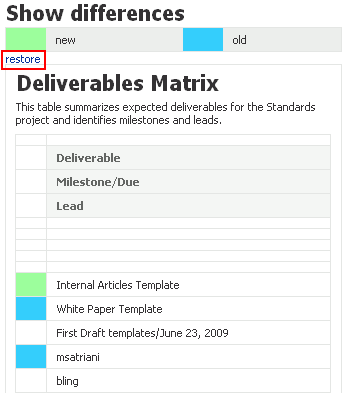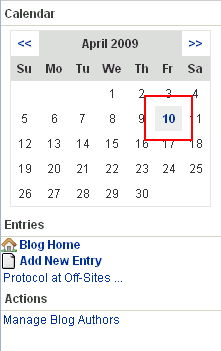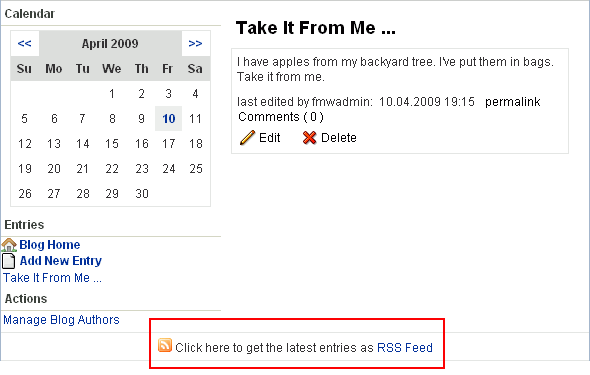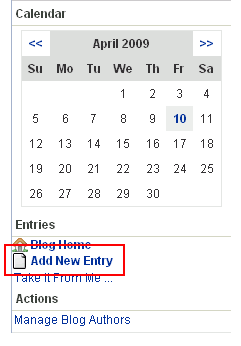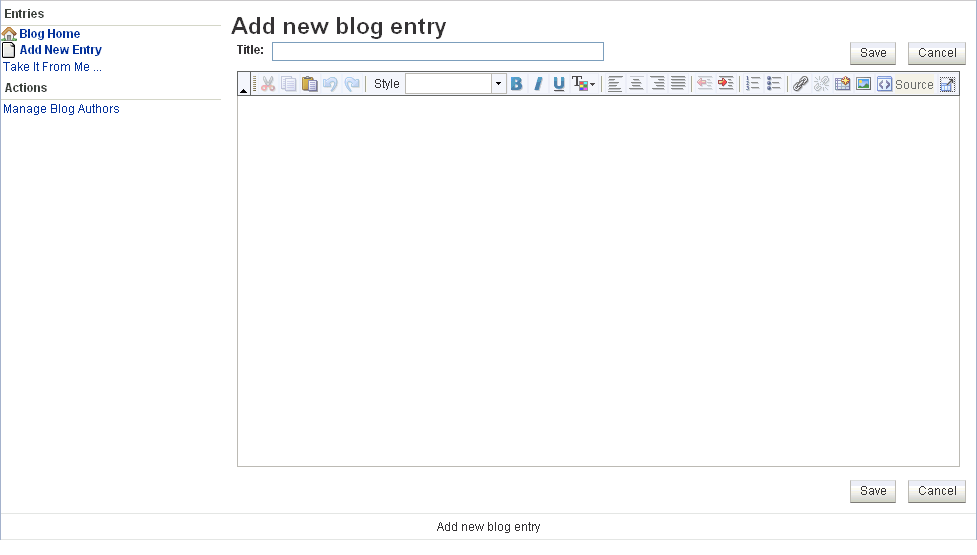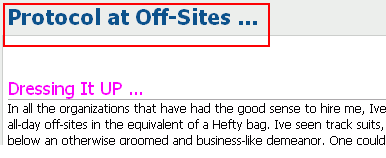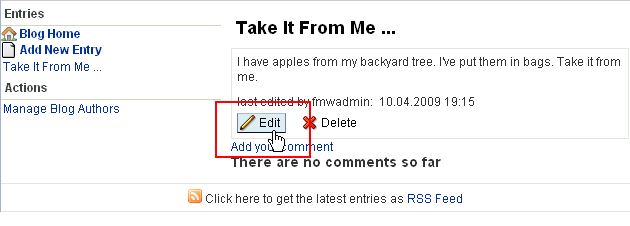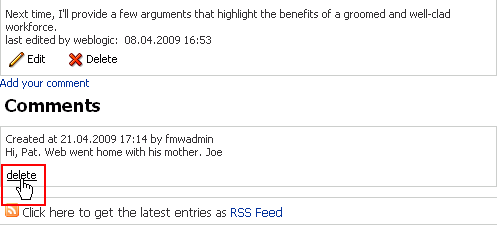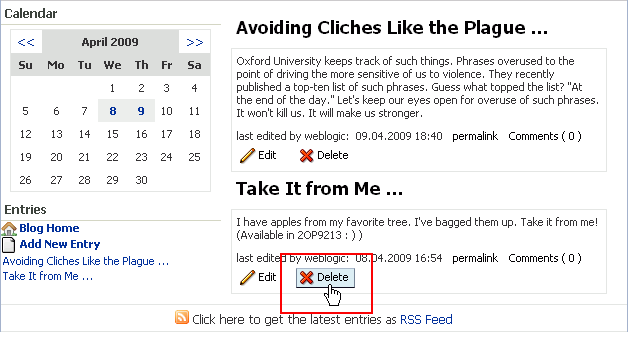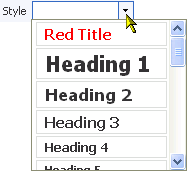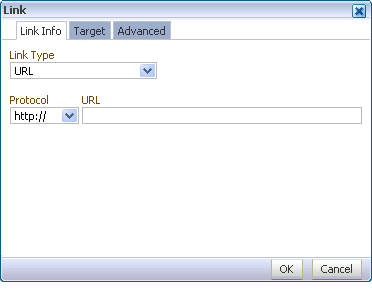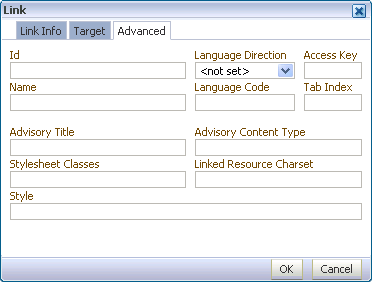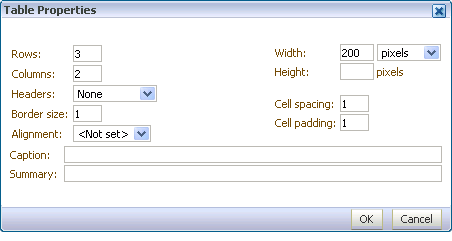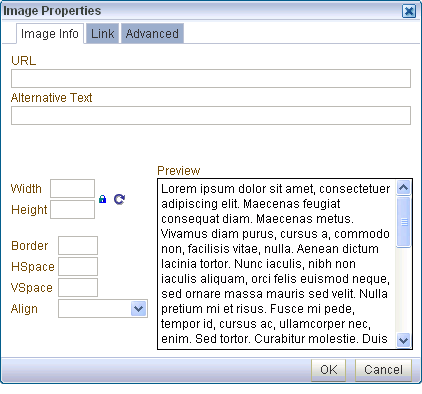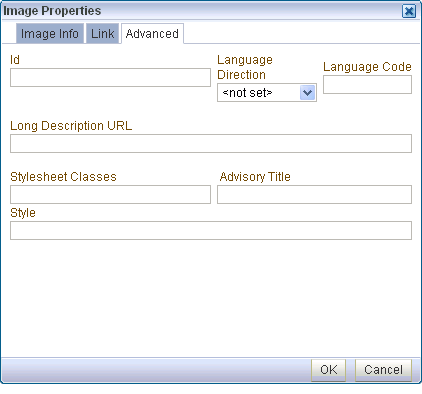23 Working with Wikis and Blogs
Wiki pages are Web pages that offer in-place editing using HTML or a simple mark-up language. Users with sufficient permission on the wiki can add, revise, or remove information. Everyone cooperates in creating content that is relevant, useful, and up-to-date.
Wikipedia is an excellent example of a wiki (http://www.wikipedia.com). Users from all over the world collaborate to create and edit Wikipedia pages, resulting in a rich, dynamic knowledge base for everyone's benefit.
In contrast, blogs are personal records of an individual user's experience and opinions. The word blog is a contraction of the term Web log. It was coined to describe the online diaries spawned in the late 1990's.
The same mechanism that produces wiki capability in WebCenter applications, also produces blog capability: the Oracle WebCenter Wiki and Blog Server.
This chapter discusses exposing wikis and blogs in WebCenter applications and creating and editing wiki pages and blog entries. It contains the following subsections:
Note:
Check the Oracle Technology Network (http://www.oracle.com/technology/products/webcenter/index.html) for post-release enhancements that provide an even tighter integration of wiki and WebCenter and additional useful features.23.1 What You Should Know About Wikis and Blogs
Wikis epitomize the concepts of community and collaboration by allowing all authorized community members to contribute their information to the greater body of knowledge. For example, one group member might create a Frequently Asked Questions document and invite all members to add to or revise the information. The target audience might be allowed to update the document, too. However, wiki page permissions can block users from editing the document if this is required.
In WebCenter Spaces applications, you can expose wikis in group spaces. In custom WebCenter applications, you can expose wikis on any application page. You can have multiple wikis per group space or per page. There is no limitation on the number of wikis you expose in your application.
Wiki pages provide three main modes: View, Edit, and Info. Use View mode to view page content. Use Edit mode to revise page content, and use Info mode to view information about the current page, including its creator and date created, its modifier and date modified, total number of times edited, and the like (see Section 23.3.1.4, "Accessing Information About a Wiki Page"). Additionally, the Information page provides a means of restoring an earlier version of the current page (see Section 23.3.1.6, "Restoring an Older Version of a Wiki Page").
You can configure your wiki to display as many or as few wiki tools as you like. Use the query string parameter inline to control how much wiki capability to render (for more information, see Table 23-2, "Query String Parameters in WebCenter Spaces Wiki and Blog URLs"). For example, Figure 23-14 depicts a wiki page rendered with inline=0 in its source URL.
Use this mode for wiki administrators. It includes a toolbar of useful links across the top of the page, a search feature, and additional navigation under the General heading.
Figure 23-2 depicts a wiki page rendered in inline=1 mode.
Note the absence of the banner and the rows of links. Use this mode when embedding wiki pages into a portal or custom application.
Figure 23-3 depicts a wiki page rendered in inline=2 mode.
Note the absence of left-column navigation. Use this mode only for wiki pages where you plan to exclude any additional form of wiki navigation.
Blogs provide a useful tool for evangelizing technology, technique, or technical expertise or simply for expressing opinions. Blogs can come from the perspective of one or more subject matter experts or from one person with a lot of opinions. Blogs, like wikis, can be private or published to a wider audience. Typically, blogs additionally invite the entry of reader comments.
In WebCenter Spaces applications, expose blogs in both personal and group spaces. In custom WebCenter applications, expose blogs on any application page. You can have multiple blogs per group space, personal space, or page. There is no limitation on the number of blogs you expose in your application.
Like wikis, blogs present additional information depending on the value you provide for the inline query string parameter (see Table 23-2, "Query String Parameters in WebCenter Spaces Wiki and Blog URLs", for more information). For example, Figure 23-4 depicts a blog rendered in inline=0 mode.
Use this mode for blog administrators. It includes a banner and toolbar with useful links and a search feature. Additionally, it provides the General heading with its associated list of blog management and monitoring links (see Section 23.3.2.6, "Viewing Information About a Blog").
Figure 23-5 depicts a blog rendered in inline=1 mode.
Notice the absence of the page banner, links, search, and the General heading with all of its associated links. Use this mode when embedding wiki pages into a portal or custom application.
Blogs rendered in inline=2 mode render exactly like those rendered in inline=1.
Both wikis and blogs provide a swift method for returning to their home pages. For a wiki, this is the welcome page of the current domain. For a blog, this is the first entry on the current blog page.
To return to a wiki home page, click the WelcomePage link or its equivalent in left-column navigation (Figure 23-6).
To return to a blog home page, click the Blog Home link or its equivalent in left-column navigation (Figure 23-7).
When you introduce a wiki or a blog into your WebCenter application, it renders within the application context. For example, a user navigates to a WebCenter application page and views your wiki within the context of that page.
Note:
The wiki and blog content that is exposed within the context of the application page is not affected by the controls associated with the page. For example, the Edit Page command on a Page Actions menu enables you to edit the WebCenter Spaces page that exposes a wiki or a blog, but does not enable you to edit the wiki or blog itself. For information about editing a wiki page, see Section 23.3.1.2, "Editing a Wiki Page." For information about editing a blog entry, see Section 23.3.2.3, "Editing a Blog Entry."In WebCenter applications, wiki and blog services are powered by an Oracle WebCenter Wiki and Blog Server back-end. The back-end categorizes its content into domains and pages. Administrators create domains, and authorized users create pages within a given domain. The administrator can also create a menu for each domain, which enables users to quickly access domain pages and other built-in functions, such as popular pages. The wiki tracks every version of the page, including its authors and creation and revision dates.
In the WebCenter Spaces application, domain creation is automatic. Whenever you use the scope parameter, the back-end either navigates to the implied group space's domain or creates the implied domain if it does not exist (see Table 23-2, "Query String Parameters in WebCenter Spaces Wiki and Blog URLs").
Query string parameters are bits of information you add to a URL to refine the behavior of the URL target. The influence of a parameter value is maintained over the course of a full browser session, no matter whether you navigate away from and back to the page where the value is applied. See Table 23-2 for query string parameters that are relevant to wiki pages and blogs.
In a WebCenter Spaces application, you can expose wikis and blogs through a Web page style or a URL-consuming portlet. In custom WebCenter applications, you can expose wikis and blogs through an iFrame or a URL-consuming portlet.
Note:
By default, Oracle WebCenter and Oracle WebCenter Wiki and Blog Server do not share cookies. To enable this feature, you can update the settings in the weblogic.xml file of your WebCenter application. For more information, see Oracle Fusion Middleware Administrator's Guide for Oracle WebCenter.23.2 Exposing Wikis and Blogs in WebCenter Applications
Exposing a wiki or blog in a WebCenter application differs between a WebCenter Spaces application and a custom WebCenter application. In WebCenter Spaces, you create a page based on the Web page style, then provide a properly formatted URL that targets the Oracle WebCenter Wiki and Blog Server back-end. Additionally, you can place a URL-consuming portlet on an application page and configure it to consume a wiki or blog URL. In a custom WebCenter application, you can add a portlet capable of consuming a URL to a page and provide the URL. In both WebCenter Spaces and custom WebCenter applications, the portlet can be the Web Clipping portlet or a custom portlet capable of consuming a URL.
Note:
Custom applications provide additional wiki and blog creation methods, but these are design-time techniques, dependent on a given developer's particular approach. Design-time techniques fall outside the scope of this guide.This section describes how to expose a wiki or a blog in WebCenter applications. It contains the following subsections:
23.2.1 Exposing a Wiki or Blog in a WebCenter Spaces Application
In addition to exposing wikis and blogs within the context of a WebCenter Spaces page, you may also want to link to specific wiki and blog pages from other application locations. This section describes how to expose and how to link to a wiki or blog in a WebCenter Spaces application. It contains the following subsections:
23.2.1.1 Exposing a Wiki or a Blog on a WebCenter Spaces Page
To expose a wiki page or a blog in a WebCenter application, you first create a page using the Web page style, and then provide a URL to the Oracle WebCenter Wiki and Blog Server in the Oracle Composer Component Properties dialog box.
Note:
In addition to stepping you through this configuration, this section steps you through default page creation. You may care to take a more customized approach. For information about different page-creation options, see Chapter 6, "Creating, Editing, and Deleting Pages."By default, when you add a blog to a page users do not have permission to create blog entries. Before users can add blog entries, you or your application administrator must set up permissions on Oracle WebCenter Wiki and Blog Server to allow all users to create blog entries. Specifically, you must grant BlogAdmin permission to the USER role. For more information, see Oracle Fusion Middleware Administrator's Guide for Oracle WebCenter.
To expose a wiki or a blog on a WebCenter Spaces application page:
-
Log in to your WebCenter Spaces application.
For information on how to log in, see Section 2.2.1, "Logging In to a WebCenter Application."
-
Go to the location in your application where you want to expose a wiki or a blog.
For assistance with locating a page or a group space in WebCenter Spaces, see Section 2.4, "Hiding, Showing, Opening, and Closing Pages."
-
From the Page Actions menu, select the Create Page command (Figure 23-8).
The Create Page dialog box opens (Figure 23-9).
-
In the Page Name field, enter a display name for the page.
The name you enter here appears on the page's tab and in the Manage Pages dialog box.
-
Optionally, select a page design scheme from the Scheme pick list (Figure 23-10).
The Scheme pick list provides a selection of background color and image schemes for the new page. For a preview of seeded schemes, see Table 6-2, "Default Page Schemes".
-
Select the Web Page style (Figure 23-11).
-
Click the Create button.
The new page opens in Oracle Composer (Figure 23-12).
Figure 23-12 A Page Created Using the Web Page Style Viewed Through Oracle Composer

Description of "Figure 23-12 A Page Created Using the Web Page Style Viewed Through Oracle Composer"
-
Click the Edit icon at the top of the Web Page (Figure 23-13).
The Component Properties dialog box opens (Figure 23-14).
-
In the Short Desc field, enter
ALTtext for the page.For example,
FinanceProject wiki. -
In the Source field, enter the URL for your wiki or blog page.
Table 23-1 illustrates the various formats to use for this URL, depending on the type of space and the type of site (wiki or blog) you are creating.
Table 23-1 URL Formats for Exposing Wikis and Blogs in WebCenter Spaces
Scope Type URL Format Group
Wiki
http://<server>:<port>/owc_wiki/page/show.jz?inline=1&scope=#{communityContext.communityName}The variable
#{communityContext.communityName}is literal. Enter it exactly as it appears here.Group
Blog
http://<server>:<port>/owc_wiki/blog/list.jz?inline=1&scope=#{communityContext.communityName}The variable
#{communityContext.communityName}is literal. Enter it exactly as it appears here.Personal
Blog
http://<server>:<port>/owc_wiki/blog/list.jz?inline=1&name=#{facesContext.externalContext.remoteUser}The variable
#{facesContext.externalContext.remoteUser}is literal. Enter it exactly as it appears here.Included in these URLs are query string parameters that provide configuration information for the link target. Parameters, such as
inlineandtheme, are session-level variables. Once the URL passes session-level variables to the target, the variable values continue to apply, even if you leave and return to the original target page. A way to change a session level variable is to enter a different value in the target URL, for exampletheme=default.Table 23-2 lists and describes the parameters you can use with WebCenter Spaces wiki and blog URLs.
Table 23-2 Query String Parameters in WebCenter Spaces Wiki and Blog URLs
Parameter Description http://<server>:<port>/owc_wiki/blog/list.jz?inline=1&name=#{facesContext.externalContext.remoteUser}-
Value of
0displays the Oracle Wiki Server default user interface and features, including a menu wiki page in the current domain. Use the menu page to create custom navigation links. The modeinline=0is the recommended mode for wiki administrators. -
Value of
1strips away nonessential wiki and blog chrome. It also renders left-side navigation that lists all wiki or blog pages within the current domain. This is the recommended mode when integrating with a custom application. -
Value of
2is similar toinline=1, except it turns off left-side navigation.
http://<server>:<port>/owc_wiki/blog/list.jz?inline=1&name=#{facesContext.externalContext.remoteUser}Facilitates navigation to a specific blog, attributed either to a particular domain or user. The default value,
#{facesContext.externalContext.remoteUser}delivers the current user's user name. Enter this Expression Language expression as it appears here.http://<server>:<port>/owc_wiki/page/show.jz?inline=1&page=<domain>:<wikiPageName>
Facilitates navigation to a specific page in a specified domain. This variable follows the syntax:
page=<domain>:<wikiPageName>. Fordomain, enter the domain under which the wiki page resides; forwikiPageName, enter the display name of the wiki page.For more information, see Section 23.2.1.2, "Creating a Link to a Wiki or Blog in WebCenter Spaces."
This parameter is useful for integrating wiki pages into an application when you want wiki links to navigate to an embedded wiki page rather than directly to the page on the Oracle WebCenter Wiki and Blog Server.
Enables the specification of an encoded URL to which a domain and page are appended when the Oracle WebCenter Wiki and Blog Server renders links to wiki pages. This applies only when inline=1.
Note: Check the Oracle Technology Network (
http://www.oracle.com/technology/products/webcenter/index.html) for post-release enhancements that provide a more explicit usage guideline for this parameter.http://<server>:<port>/owc_wiki/page/show.jz?inline=1&scope=#{communityContext.communityName}Creates a new domain with the name specified for the scope variable. If such a named domain exists, navigates to it.
If the scope variable creates the domain on the fly, it also creates the home page (WelcomePage) and redirects the user to that page. Domain creators can specify another name besides WelcomePage for the start (default) page.
The default value,
#{communityContext.communityName}delivers the domain of the group space within which you are creating the wiki or blog. Enter this Expression Language expression as it appears here.http://<server>:<port>/owc_wiki/page/show.jz?inline=1&scope=#{communityContext.communityName}&theme=blueDynamically applies the specified wiki theme to the requested page (theme must be present on both the Oracle WebCenter Wiki and Blog Server and the WebCenter application server).
-
noneturns off CSS. -
defaultapplies the default theme specified on the server. -
<theme_name>applies the specified wiki theme/CSS to the wiki page and all its children.
Seeded wiki themes include the following (use the value in parenthesis in the parameter):
-
Bighorn (
bighorn) -
Blue (
blue) -
Blue Sky (
bluesky) -
Deep Sea (
deepsea) -
Dew (
olive) -
Dusk (
monochrome) -
Flatirons (
flatirons) -
Midnight (
onyx) -
Mist (
white) -
Red (
red) -
Sand (
sand) -
Storm (
storm) -
Tech Gray (
tech_gray) -
WebCenter Default (
default) -
WebCenter Theme (
webcenter) -
Wiki Default (
wiki)
Tip: To use the same theme currently used by your WebCenter application, add the following EL expression to your wiki or blog URL:
theme=#{adfFacesContext.skinFamily}For information about other useful Expression Language expressions, see Section 7.4.5, "Using Expression Language (EL) Expressions with Component Properties."
-
-
Click the OK button to save your changes and exit the dialog box.
The page refreshes, exposing your wiki or blog (Figure 23-15).
Tip:
The first screen you see may require your login credentials for your Oracle WebCenter Wiki and Blog Server. Enter your credentials to access the wiki page. You can do this in page edit mode and in page view mode.Note:
For information about next steps, see Section 23.3, "Working with Wiki and Blog Content." -
Click the Save button to save your changes in Oracle Composer (Figure 23-16).
-
Click the Close button to exit Oracle Composer (Figure 23-17).
23.2.1.2 Creating a Link to a Wiki or Blog in WebCenter Spaces
In developing your wikis and blogs, you may want to create links within and to the wiki or blog from a WebCenter Spaces application page. Create internal links using wiki mark-up (see Section 23.3.4, "Using Wiki Mark-Up"). Create links to wikis and blogs from WebCenter Spaces application pages using the layout component Hyperlink or Image.
This section specifically describes the process of adding and configuring a Hyperlink layout component to an application page. To add an Image layout component, follow the steps described in this section, but add an Image in lieu of a Hyperlink layout component.
To link to a wiki page or a blog from a WebCenter Spaces application page:
-
Log in to your WebCenter Spaces application.
For information on how to log in, see Section 2.2.1, "Logging In to a WebCenter Application."
-
Navigate to the wiki or blog to which you want to create a Hyperlink, and copy its link location.
One way to copy a wiki or blog page link location is to right-click the target page on the navigation panel located on the left side of the wiki or blog page (Figure 23-18).
To get a URL for a specific blog entry, you can also copy the link location of the permalink that renders just below the blog entry (Figure 23-19).
Use your browser's context menu to copy the target page's URL.
Note:
For this navigation panel to display, theinlineparameter in the wiki or blog URL must be set to1. See Table 23-2, "Query String Parameters in WebCenter Spaces Wiki and Blog URLs" for more information. -
Go to the page where you want to add a Hyperlink.
For information about locating pages, see Section 2.4, "Hiding, Showing, Opening, and Closing Pages."
-
From the Page Actions menu, select Edit Page to open Oracle Composer (Figure 23-20).
Note:
If the Edit Page command is not available on the Page Actions menu or the Page Actions menu does not display, it is likely that you do not have sufficient page access privileges. If this is the case, ask your application administrator for the privilege to edit pages. See Section 2.7, "Contacting Your Application Administrator." -
In Oracle Composer, click the Add Content button associated with the region to which to add the Hyperlink (Figure 23-21).
The Oracle Composer Catalog opens.
-
In the Catalog, click the Open link next to Layout.
The Layout folder opens.
-
Click the Add link next to the Hyperlink layout component (Figure 23-22).
-
Click the Close button to close the Catalog.
-
Click the Edit icon associated with the Hyperlink you added to the page (Figure 23-23).
Note:
By default, Hyperlink layout components display a floating header that appears when you roll your mouse pointer over the Hyperlink. You can additionally use the handle on the header to reposition the Hyperlink within the current region or within another region.
The Component Properties dialog box opens, displaying Hyperlink properties (Figure 23-24).
Table 23-3 lists and describes the Hyperlink properties to use in this procedure.
Table 23-3 Hyperlink Properties Under Property Inspector
Property Description Enter a link text for the Hyperlink.
Enter a URL for the Hyperlink target destination. See Table 23-4.
Select this option to specify that the link target should open in either a new browser tab or a new browser window. Whether a tab or a window is used depends on the innate capability of the browser.
When this option is not selected, the link target opens in the current browser window.
-
In the Title field, enter link text for the Hyperlink.
For example, enter,
Team minutes for Finance Project. -
In the Destination field, enter the target URL for the wiki page or the blog.
Paste the URL you copied in step 2, adding the parameter
inline=1. Follow a format described in Table 23-4.Table 23-4 Formats for Hyperlinks to Wikis and Blogs
Target Scope URL Format wiki
group
http://<server>:<port>/owc_wiki/page/show.jz?inline=1&page=<domain>:<wikiPageName>
blog
group
http://<server>:<port>/owc_wiki/blog/list.jz?inline=1&name=<domain>
blog
personal
http://<server>:<port>/owc_wiki/blog/list.jz?inline=1&name=<user>
In these examples,
domainis the name of the group space where the wiki or blog is exposed. Enter underscores for any spaces included in the group space display name; for example,Finance ProjectbecomesFinance_Project. For the variablewikiPageName, enter the name of the wiki page you are targeting. The wiki page name is used in the wiki's left-pane navigation. It may differ from the page display name, which you do not use. See Table 23-2 for additional query string parameters you can include in your URL. -
Set the Open in a new window check box as you prefer.
-
Click the OK button to close the dialog box.
-
Click the Save button to save your changes in Oracle Composer (Figure 23-25).
-
Click the Close button to exit Oracle Composer (Figure 23-26).
23.2.2 Exposing a Wiki or Blog in a Custom WebCenter Application
In custom WebCenter applications, how you go about exposing a wiki or a blog is open to your particular application development approach. There are two basic approaches:
-
Expose a wiki on a page through an iFrame.
-
Bring a wiki into your application through the Web Clipping portlet or any portlet capable of consuming a URL.
Note:
For information about the Web Clipping portlet, see Chapter 33, "Working with the Web Clipping Portlet."
Use the portlet approach for runtime wiki integration. Use the iFrame approach for design-time wiki integration.
Note:
Design-time application development falls outside the scope of this guide. For more information, see Oracle Fusion Middleware Developer's Guide for Oracle WebCenter.When you reach the point where you enter the wiki or blog source in the portlet, use the formats provided in Table 23-5.
Table 23-5 URL Formats for Exposing Wikis and Blogs in Custom WebCenter Applications
| Type | URL Format |
|---|---|
|
Wiki |
|
|
General Blog |
|
|
Personal Blog |
|
If you want to add a link to a specific wiki page or to a blog on one of your application pages, use the URL formats provided in Table 23-6.
Table 23-6 Formats for Hyperlinks to Wikis and Blogs
| Target | URL Format |
|---|---|
|
Wiki |
|
|
General Blog |
|
|
Personal Blog |
|
Included in these URLs are query string parameters that provide configuration information for the link target. Parameters, such as inline and theme, are session-level variables. Once the URL passes session-level variables to the target, the variable values continue to apply, even if you leave and return to the original target page. A way to change a session level variable is to enter a different value in the target URL, for example theme=default.
Table 23-7 lists and describes query string parameters you can use in custom WebCenter application wiki and blog URLs.
Table 23-7 Query String Parameters to Use in Custom WebCenter Application Wiki and Blog URLs
| Session Variable | Description |
|---|---|
http://<server>:<port>/owc_wiki/page/show.jz?inline=1&scope=<domain>
|
|
http://<server>:<port>/owc_wiki/blog/list.jz?inline=1&name=<domain> Facilitates navigation to a specific blog, attributed either to a particular domain or user. |
|
http://<server>:<port>/owc_wiki/page/show.jz?inline=1&page=<domain>:<wikiPageName> Facilitates navigation to a specific page in a specified domain. This variable follows the syntax: |
|
http://<server>:<port>/owc_wiki/page/show.jz?inline=1&scope=<domain> Creates a new domain with the name specified for the scope variable. If such a named domain exists, navigates to it. If the scope variable creates the domain on the fly, it also creates the home page (WelcomePage) and redirects the user to that page. Domain creators can specify another name besides WelcomePage for the start (default) page. |
|
http://<server>:<port>/owc_wiki/page/show.jz?inline=1&scope=<domain>&theme=sand Dynamically applies the specified wiki theme to the requested page (theme must be present on both the Oracle WebCenter Wiki and Blog Server and the application server).
Oracle Wiki Server provides seeded wiki themes, which you can include in your wiki and blog URLs. Use any of the following (use the value in parenthesis in the session variable):
Tip: To use the same theme currently used by your WebCenter application, add the following EL expression to your wiki or blog URL:
theme=#{adfFacesContext.skinFamily}
For information about other useful Expression Language expressions, see Section 7.4.5, "Using Expression Language (EL) Expressions with Component Properties." To ensure that your application chrome renders consistently, you'll want to additionally place a copy of all seeded CSS files on your application server. |
|
|
This parameter is useful for integrating wiki pages into an application when you want wiki links to navigate to an embedded wiki page rather than directly to the page on the Oracle WebCenter Wiki and Blog Server. Enables the specification of an encoded URL to which a domain and page are appended when the Oracle WebCenter Wiki and Blog Server renders links to wiki pages. This applies only when inline=1. Note: Check the Oracle Technology Network ( |
23.2.3 Accessing Information About a Wiki Domain
A wiki domain encompasses an identified group of wiki pages. For example, in WebCenter Spaces, domains encapsulate the wiki pages associated with a particular group space. In custom WebCenter applications, a domain encapsulates all the wiki pages created for that application.
Every wiki page that exposes left-column navigation provides an entry point to a page that links to or summarizes useful information about the current domain. This section describes how to access that page and summarizes the types of information it provides.
To access information about a wiki domain:
-
Go to a wiki page within the domain you want to learn about.
-
Click the Domain Information button in the navigation panel on the left side of the wiki page (Figure 23-27).
Note:
For the navigation panel depicted in Figure 23-27 to appear, the URL to the wiki page must include eitherinline=0orinline=1. For more information, see Table 23-2, "Query String Parameters in WebCenter Spaces Wiki and Blog URLs".The domain information page opens (Figure 23-28).
Figure 23-28 A Wiki Domain Information Page
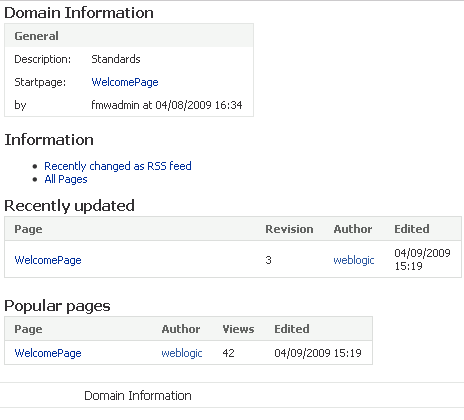
Description of "Figure 23-28 A Wiki Domain Information Page"
Table 23-8 lists and describes the type of information you can access from the domain information page.
Table 23-8 Categories of Content on a Wiki Domain Information Page
Content Description Provides summary information about the domain, including:
-
The domain name (labeled Description)
-
A link to the domain welcome page
-
The domain's creator and date and time of creation
Provides links to more detailed information about domain content, including:
-
Recently changed as RSS feed—A link you can use in an RSS reader to track recently-changed pages in the current domain.
-
All pages—A table that summarizes general information about domain-associated wiki pages. Information includes page name, number of times revised, access mode (editable by all users or only by authenticated users), date last revised and user who last revised.
-
Activities—Summarizes activities on domain pages, including the thing acted on (such as Blogentry), the action performed (such as DELETED), a link to the changed object, the user name of the person performing the action, and the date the action was performed.
A table that lists the most recently updated domain pages. Includes such information as a link to the updated page, the number of revisions, a mailto link to the user who made the change, and the date and time the change was made.
A table that lists the most visited domain pages. Includes such information as a link to the page, the user name of the person who created the page, the number of times users have viewed the page, and the date and time a user last viewed the page.
Use a combination of the left-column navigation and your browser's Back button to navigate into and out of these pages.
-
23.2.4 Adding and Removing Additional Blog Authors
By default, blog entries can be added only by the person who owns the blog. In a personal space, that is the person who owns the personal space. In a domain (such as a blog associated with a group space), that is the wiki administrator.
The Manage Blog Authors action, which displays in a blog's left-column navigation, enables you to specify additional users who can add blog entries. Removing additional blog authors is as easy as clicking a link.
To enable or disable additional blog authors:
-
Navigate to the blog you want to open or close to other users' entries.
-
Click the Manage Blog Authors link (Figure 23-29).
-
The next step depends on whether you want to add or remove a blog author:
-
To add a blog author:
From the Username pick list (Figure 23-30), select the user name of the person you want to enable to add blog entries, and click the Add button.
The selected user appears on the Members list (Figure 23-31).
-
To remove a blog author, click the remove link next to the author's user name under the Members heading (Figure 23-32).
-
23.3 Working with Wiki and Blog Content
Oracle Wiki Server provides useful tools for creating and managing wiki and blog content. Easy-access buttons are available for instantly creating new wiki pages and new blog entries. Editing a wiki page is a simple matter of bringing an Edit tab forward. Editing a blog entry is as simple as clicking an Edit button. To create content, you can use either HTML, through an embedded HTML editor, or standard wiki mark-up.
This section describes how to use content creation and management tools provided through the Oracle Wiki Server. It contains the following subsections:
23.3.1 Working with Wiki Pages
Once you have exposed a wiki in your WebCenter application, you can start right in creating wiki pages and providing content. Oracle Wiki Server provides simple controls for creating, editing, and deleting wiki pages. This section describes how to use them. It contains the following subsections:
23.3.1.1 Creating a Wiki Page
When you first expose a wiki on a group space page, a wiki domain associated with that group space is also created automatically. Once the domain is created, you can begin adding pages within it. This section tells you how.
To create new pages within a group space wiki:
-
In your WebCenter application, navigate to the wiki where you want to add a page.
-
Click the New Wiki Page button on the wiki page (Figure 23-33).
The New Wiki Page screen opens (Figure 23-34).
-
In the Page name field, enter a page name, such as
MyWikiPage.Follow the wiki page naming convention.
Note:
For more information on the wiki page naming convention, see Section 23.3.4, "Using Wiki Mark-Up." -
From the Type menu, select the format to use in developing page content.
Choose from:
-
HTML—Select to add styles, tables, links, and images using a simple HTML editor. Section 23.3.3, "Using Wiki HTML Editor Controls," illustrates and describes HTML Editor Controls.
-
Wiki markup—Select to add styles, tables, links, and images using wiki mark-up (see Section 23.3.4, "Using Wiki Mark-Up")
Note:
HTML and wiki mark-up are almost mutually exclusive. You cannot use wiki mark-up in the simple HTML editor; you can use only a limited set of HTML tags in wiki mark-up. For more information, see Section 23.3.4, "Using Wiki Mark-Up." -
-
Optionally, select a template.
Choose from:
-
Create empty page—Creates a blank page.
-
SimpleWikiMarkupPage—Creates a page with a few starter wiki mark-up elements (Figure 23-35).
-
SimpleHTMLPage—Creates a page with a few starter HTML tags (Figure 23-36).
Always select the template for the Type you specified in step 4. That is, for the HTML Type, select either Create empty page or SimpleHTMLPage; for the Wiki markup Type, select either Create empty page or SimpleWikiMarkupPage.
-
-
Click the New Wiki Page button.
The Edit page screen opens (Figure 23-37).
Note:
For the navigation panel shown in Figure 23-37 to appear, theinlineparameter in the wiki URL must be set to0or1. See Table 23-2, "Query String Parameters in WebCenter Spaces Wiki and Blog URLs" for more information. -
On the Edit page screen, select a page access mode from the Mode menu.
-
editable by everyone—Select to enable all users with access to the wiki to edit the page.
-
restricted to logged in users—Select to restrict editorial access to logged in users.
-
only admins are allowed to edit—This selection appears when the current user is a wiki administrator. Use this setting to restrict editorial access to wiki administrators.
-
restricted to members of the domain—restricts editorial access to members of the current domain, when domain members are defined. (In WebCenter integrations, users do not typically specify domain members, so this option does not appear most of the time.)
-
-
Enter content using HTML or wiki mark-up, depending on the Type you selected in step 4.
For information about HTML editor controls, see Section 23.3.3, "Using Wiki HTML Editor Controls." For information about wiki mark-up, see Section 23.3.4, "Using Wiki Mark-Up."
-
Click the Save button when you have finished.
This saves your changes and closes the editor.
23.3.1.2 Editing a Wiki Page
To enter edit mode on a wiki page:
-
Navigate to the wiki page you want to edit.
-
Click the Edit button (Figure 23-38).
The page opens in a simple HTML editor or in a plain text editor, depending on the options selected when the page was created (Figure 23-39).
-
Edit the page, and then click the Save button when you have finished.
For information about HTML editor controls, see Section 23.3.3, "Using Wiki HTML Editor Controls." For information about wiki mark-up, see Section 23.3.4, "Using Wiki Mark-Up."
23.3.1.3 Printing a Wiki Page
To print a wiki page, click the Print icon that displays toward the top of the page (Figure 23-40), and then follow the resulting screen directions from your printer driver.
23.3.1.4 Accessing Information About a Wiki Page
In addition to domain information (see Section 23.2.3, "Accessing Information About a Wiki Domain"), you can obtain information about a specific wiki page.
To access information about a specific wiki page:
-
Go to the wiki page of interest.
-
Click the wiki page's Info button.
The wiki Information page opens (Figure 23-41).
Table 23-9 lists and describes the types of information that appear on a wiki information page.
Table 23-9 Information Types on a Wiki Page Information Page
Label Description Name
The display name of the current wiki page
Created by
The user name of the person who created the current wiki page
Last author
The user name of the last person to revise the current wiki page
Created at
The date and time the current wiki page was created
Last update
The date and time the current wiki page was last revised
Comment
The comment associated with the current wiki page
Revision
The number of times the current wiki page has been revised
Mode
The editorial access rule that applies to the current wiki page
Views
The number of times the current wiki page has been accessed
Permalink
A reusable link to the current wiki page (see Section 23.2.1.2, "Creating a Link to a Wiki or Blog in WebCenter Spaces")
Recently changed
A summary table of the most recent changes to the wiki page
Use the view link to open an earlier version of the current wiki page.
Use the diff link to compare an older version of the wiki page with the current version. Differences are highlighted in colors showing new content and old (see the following graphic).

On the diff page, you can use a restore link to make an earlier version the current version. for more information, see Section 23.3.1.6, "Restoring an Older Version of a Wiki Page."
history
A link to a full list of all revisions made to the current wiki page
references
A link to a page listing all other wiki pages that link to this wiki page
The reference page additionally provides a query feature that enables you to discover links to other pages in this domain. Enter a wiki page name in the search field, and click Query to view a list of wiki pages on which the specified wiki page is referenced (see the following graphic).

23.3.1.5 Deleting a Wiki Page
When you delete a wiki page from your WebCenter application, you are actually deleting it from the Oracle WebCenter Wiki and Blog Server. That is, you are deleting wiki content rather than a WebCenter application page.
You cannot delete the Welcome page that marks the exposure of your wiki content within your application. However, you can easily delete every other wiki page you create or are permitted to delete.
Note:
Only the wiki page author and the wiki administrator see the Delete icon. Only they are able to delete wiki pages.To delete a wiki page:
-
Navigate to the wiki page you want to delete.
-
Click the Delete icon at the top of the wiki page (Figure 23-42).
-
In the confirmation dialog box, click OK.
The wiki page is deleted immediately. Its display name is removed from the wiki's left-column navigation.
23.3.1.6 Restoring an Older Version of a Wiki Page
To make an older version of a wiki page the current version:
-
Go to the wiki page of interest.
-
Click the Info button to open the Information page (Figure 23-43).
-
Under Recently changed, click the diff link next to the version you want to make the current version (Figure 23-44).
If the version of interest is not listed under Recently changed, click the history link instead, and then, on the resulting page, click the diff link next to the version of interest.
The Show Differences page opens (Figure 23-45).
-
Click the restore link toward the top of the page (Figure 23-46)
The older version is restored as the current version. The previously current version becomes an older version.
23.3.2 Working with Blog Entries
This section describes how to create, edit, delete, and offer comments on a blog entry. It contains the following subsections:
23.3.2.1 What You Should Know About Blog Entries
Blog entries for a given day render in a continuous column on a single page (Figure 23-47).
Each entry occupies its own region within the column and each region comes equipped with controls for revising, commenting on, and deleting the entry. Newer entries are added to the top of the blog.
Links under the Entries heading on the left side of the page provide controls for navigating to the blog's first entry (Blog Home) and creating a new blog entry (Add New Entry). Additionally, as entries are added, their headings automatically appear on this list of links.
Blog pages are automatically organized according to month of entry. Users can access the various monthly entries using the calendar that appears to the left of the blog content. The dates with associated entries are linked to those entries. Click a date in the calendar to go to the entries for a particular day (Figure 23-48).
Use the arrows to the left and right of the month to navigate to previous and later months.
A link for grabbing a blog news feed (RSS Feed) appears below the content area (Figure 23-49).
Note:
For information about news feeds in WebCenter applications, see Chapter 28, "Working with the RSS Service".23.3.2.2 Creating a Blog Entry
-
Navigate to the blog where you want to create an entry.
-
Click the Add New Entry link under Entries on the left side of the blog (Figure 23-50).
The Add new blog entry page opens (Figure 23-51).
-
In the Title field, enter a display name for this blog entry.
The title displays as a link in the left-side navigation and as the main heading over the text area (Figure 23-52).
-
In the Text field, enter blog content.
The Text field provides a simple HTML editor for adding style elements and HTML to your content. See Section 23.3.3, "Using Wiki HTML Editor Controls,", for illustrations and descriptions of HTML editor controls.
-
Click the Save button below the editor to save your changes and exit the editor.
23.3.2.3 Editing a Blog Entry
-
Navigate to the blog where you want to edit an entry.
-
Click the Edit button below the entry (Figure 23-53).
-
Use the HTML editor controls as described in Section 23.3.3, "Using Wiki HTML Editor Controls."
-
Click the Save button above or below the editor to save your changes and exit the editor.
23.3.2.4 Adding a Blog Comment
A great feature of blogs is the facility to respond to blog entries. This section describes how.
To comment on a blog entry:
-
Navigate to the blog where you want to comment on an entry.
-
Click the Add your comment link below the entry (Figure 23-54).
-
Enter your comment in the Text field (Figure 23-55).
Enter comments in plain text, or, if you prefer, use wiki mark-up. For information about wiki mark-up, see Section 23.3.4, "Using Wiki Mark-Up."
-
Click the Save button to save your changes and exit the editor.
23.3.2.5 Deleting a Blog Comment
Users identified as blog authors (see Section 23.2.4, "Adding and Removing Additional Blog Authors") are authorized to delete blog comments. This section describes how.
Note:
A blog comment is a comment on a blog entry. For information about deleting a blog entry, see Section 23.3.2.7, "Deleting a Blog Entry."To delete a blog comment:
-
Navigate to the blog where you want to delete a blog comment.
-
If necessary, click the Comments link to show blog comments (Figure 23-56).
-
Click the Delete link below the comment you want to remove (Figure 23-57).
Note:
You must be a designated blog author to delete a blog comment. If you are not a designated blog author, the Delete link does not show.
23.3.2.6 Viewing Information About a Blog
Blog information is available in the blog administrator view (inline=0, see Section 23.1, "What You Should Know About Wikis and Blogs," for more information). This view provides a General heading over a series of links that lead to useful and interesting information (Figure 23-58).
Table 23-10 lists and describes the types of information you can access using the links that appear under the General heading.
Table 23-10 Information Under a Blog General Heading
| Link | Description |
|---|---|
|
Links to a page that lists all recent blog activity The Latest activities page summarizes activities on domain pages, including the thing acted on (such as Blogentry), the action performed (such as DELETED), a link to the changed object, the user name of the person performing the action, and the date and time the action was performed. |
|
|
Links to a page that lists and links to all accessible wiki pages The All pages page links to all pages in the current domain, provides the number of times a page has been revised, specifies the editorial mode that applies to a page, and lists the date and time the page was last revised and the user name of the person who revised it. |
|
|
Links to a page that lists and links to all accessible blogs The All blogs page provides an RSS icon for each blog, which you can use to obtain an RSS feed for use in your favorite news feed reader; a link to the blog; a description of the blog type, either DOMAIN (a group blog) or USER (a personal blog); a mailto link to the blog owner (personal blogs only); and a link to the author's profile (personal blogs only). |
|
|
Links to a page that lists and links to recently-changed wiki pages The Recently Changed pages page provides a link to the changed wiki page, specifies the number of times the page has been revised, lists a mailto link to the person who made the revision, and records the date and time the revision was made. |
|
|
Links to a page that lists and links to frequently-viewed wiki pages Additionally, the Popular Pages page lists the wiki page author, specifies the number of times the users have viewed the page, and records the date and time a user last edited the page. |
23.3.2.7 Deleting a Blog Entry
Once you click the Delete link under a blog entry, the entry is deleted. There is no confirmation dialog box second-guessing your decision. This increases the efficiency of deleting, but also the risk. Be sure you want to permanently remove a blog entry before you click the Delete link.
To delete a blog entry:
-
Navigate to the blog where you want to delete an entry.
-
Click the Delete button below the entry (Figure 23-53).
The selected entry is deleted from the blog.
23.3.3 Using Wiki HTML Editor Controls
Oracle Wiki Server supports the use of HTML or wiki mark-up language to format page content. When you create or edit a wiki page, you can use either wiki mark-up language or HTML, depending on which was specified when the page was created. Table 23-11 illustrates and describes controls available in the HTML editor provided with wikis and blogs.
Note:
See Section 23.3.4, "Using Wiki Mark-Up," for information about wiki mark-up.Table 23-11 HTML Editor Controls
| Icon | Description |
|---|---|
|
|
Toolbar toggle switch. Click to hide the HTML editor toolbar. Click again to restore the toolbar to view. |
|
|
Cut icon. Select content, and click to remove your selection from its current location and add it to a clipboard. Alternatively, select text and press Ctrl-x. |
|
|
Copy icon. Select content, and click to copy your selection to a clipboard. Alternatively, select text and press Ctrl-c. |
|
|
Paste icon. Place your cursor where you want cut or copied content to appear, and click to paste clipboard content. Alternatively, press Ctrl-v. |
|
|
Undo icon. Click to back out of the latest change. Alternatively, press Ctrl-z. |
|
|
Redo icon. Click to restore the latest change. Alternatively, press Ctrl-y. |
|
|
Style pick list. Expand to select a style for currently-selected text. Or select a style and enter text in the selected style. |
|
|
Bold icon. Select text, and click the Bold icon to make the text bold. Or click the Bold icon and enter text in bold. Click the icon again to exit bold mode. |
|
|
Italic icon. Select text, and click the Italic icon to make the text italic. Or click the Italic icon and enter text. Click the icon again to exit italic mode. |
|
|
Underline icon. Select text, and click the Underline icon to draw an underline below text. Or click the Underline icon and enter text. Click the icon again to exit underline mode. |
|
|
Text Color pick list. Select text, and then select a color from this list to make the text the selected color. Or select a color and enter text. Select a second color or Automatic to apply a new color or the default (Automatic equals black). |
|
|
Left Justify icon. Select content, and click the Left Justify icon to align your selection left. Or click the icon and enter content. |
|
|
Center Justify icon. Select content, and click the Center Justify icon to center your selection. Or click the icon and enter content. |
|
|
Right Justify icon. Select content, and click the Right Justify icon to align your selection right. Or click the icon and enter content. |
|
|
Block Justify icon. Select content, and click the Block Justify icon to make your selection align on both the left and right sides. Or click the icon and enter content. |
|
|
Decrease Indent icon. Select content, and click the Decrease Indent icon to remove one level of indent. |
|
|
Increase Indent icon. Select content, and click the Increase Indent icon to add one level of indent. Or click the icon and enter indented content. |
|
|
Insert/Remove Numbered List icon. On a new, blank line, click to start a numbered list. Or select a line of text and click to convert it to a numbered list. Selecting a numbered item and clicking the icon removes numbered list formatting. Click again to exit Numbered List mode. |
|
|
Insert/Remove Bulleted List icon. On a new, blank line, click to start a bulleted list. Or select a line of text and click to convert it to a bulleted item. Selecting a bulleted item and clicking the icon removes bulleted list formatting. Click again to exit Bulleted List mode. |
|
|
Insert/Edit Link icon. Click to open a dialog box for entering a new hyperlink. Or select a hyperlink and click to edit. Enter link information on the Link Info tab. Refine link information on the Target and Advanced tabs.
On the Link Info tab: For Link Type, select from:
The values that follow depend on your selection:
|
|
Insert/Edit Link icon (Continued) Target tab |
Use the Target tab to refine the target link destination. From the Target pick list, select from:
In the Target Frame Name field, enter the name of the frame you are targeting in your link destination.
|
|
Insert/Edit Link icon (Continued) Advanced tab |
Use the Advanced tab to set advanced properties on your link URL.
|
|
|
Remove Link icon. Select a link, and click this icon to remove the link. Link text is preserved. |
|
|
Insert/Edit Table icon. Click to open a Table Properties dialog box and create a new table. Or select a table and click the icon to edit the table properties.
Note: The CSS delivered with WebCenter and Oracle WebCenter Wiki and Blog Server use border size, cell spacing, and cell padding all equal to |
|
|
Insert/Edit Image icon. Click to open an Image Properties dialog box and provide image-display values. The dialog box provides three tabs:
|
|
Insert/Edit Image (cont.) |
|
|
Insert/Edit Image (cont.) |
|
|
|
Source button. Click to enter or exit Source view, where you can enter your own HTML code. |
|
|
Maximize editor size icon. Click to toggle between maximizing the size of the edit window and restoring the editor to its default size. |
23.3.4 Using Wiki Mark-Up
Oracle Wiki Server supports the use of HTML or wiki mark-up language to format page content. When you create or edit a wiki page, you can use either wiki mark-up language or HTML, depending on which was specified when the page was created. Table 23-12 describes some commonly used wiki mark-up rules and examples.
Note:
For information about HTML mark-up, see Section 23.3.3, "Using Wiki HTML Editor Controls."Table 23-12 Commonly Used Wiki Markup
| Formatting Rule | Description | Syntax Examples |
|---|---|---|
|
Define headers using exclamation points (!). The number of exclamation points defines the header depth. |
!Header1 !!Header2 !!!!Header4 |
|
|
Wrap the text you want to emphasize with the following characters: Bold: * Italics: # Underlined: " |
The following is *bold text*. The following is #italicized text#. The following is "underlined text". |
|
|
Display external links either by entering the link URL: http://www.oracle.com Or by using the following format to provide a link display name: [ link display name | URL ] Display links to other wiki pages using the following format: [ link display name | wiki page name ] Note that if the internal page does not exist, wiki creates a new one and displays a question mark (?) next to the page name in the view mode. Click the question mark to edit the page. |
[ oracle | http://www.oracle.com ] [ Seattle | SeattleSupportPage ] |
|
|
Use the camel notation to name your wiki pages. This notation uses an initial upper case letter followed by lowercase letters, then another upper case letter and another series of lowercase letters, for example, [ alternate name | Wiki page name ] |
[ My Page | MyPage ] |
|
|
At the beginning of a new line, use an asterisk (*) to denote a bulleted list or the number sign (#) to denote a numbered list. |
* bulleted item 1 * bulleted item 2 # numbered item 1 # numbered item 2 |
|
|
Use HTML to create a table. Open and close the table with the <table></table> tag and define columns by using the "|" symbol. |
<table width="75%" border="0"> *col1* | *col2* Hello | world Here | I am </table> |
|
|
Any forward slashes in the image URL must go outside the quotation marks. |
<img src="" TARGET=_blank http://www.anyserver.com/image.gif"/> |
